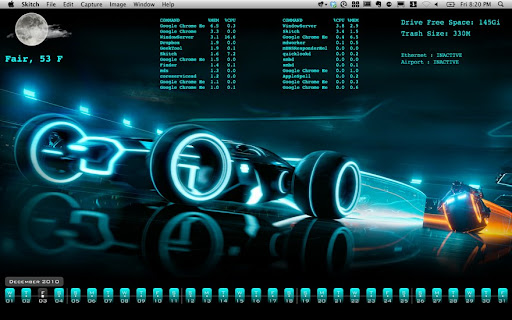
- USEFUL GEEKTOOL SCRIPTS HOW TO
- USEFUL GEEKTOOL SCRIPTS UPDATE
- USEFUL GEEKTOOL SCRIPTS ZIP
- USEFUL GEEKTOOL SCRIPTS DOWNLOAD
Rainmeter is a powerful tool that lets you create a beautiful, information-rich heads-up display… What Is GeekTool?
USEFUL GEEKTOOL SCRIPTS HOW TO
Geek to Live: Monitor your Mac and more with GeekToolīy Gina Trapani How to Create an Attractive, Customized Desktop HUD with Rainmeter GeekTool has come a ways since then, and setting up a gorgeous HUD using GeekTool is easier-and GeekTool itself is more powerful-than ever. It’s been a while since we looked at desktop customization app GeekTool. Here’s how you can make your desktop more useful but keep it looking sharp. With GeekTool, you can put all of that information right on your desktop. It may be covered with applications and windows most of the time, but your Mac’s desktop can also be an excellent source of information, including the time and date, available hard drive space, battery status, system performance, and more. While it’s hard to accidentally delete all of your files with Geektool, it is possible, so be careful. This is not recommended for anyone without prior experience with shell scripts, as these are actual shell commands and can modify your file system.

It’s easiest to learn first by tweaking other’s Geeklet scripts and then move up to writing your own. From here, you can edit the scripts for any Geeklet. Click the “…” button beside the “Command:” box, which will bring up the fullscreen editor. If you want to tweak the scripts that make Geektool function, you can do so. At the bottom of the window is the style options, from which you can set the font to anything OS X supports, including custom fonts. From Geektool’s settings, click a Geeklet to open the Properties window. Shell Geeklets output text, and you can change the look and style of each one. Scripts can be installed by dragging a new “Shell” Geeklet to the desktop and pasting the script into the “Command:” box. glet files can be installed simply by opening them and adding them to Geektool. Another great source is the Geektool subreddit. Many Geeklets can be found on the official repository. You can also get to Geektool’s settings from this menubar.įinding and Adding Geeklets to Your Desktop If you want to stop it, you will have to launch the app again and uncheck “Enable”, or click “Quit Geektool” from the menubar. If you close this window, Geektool will continue to run in the background. It’s also a good idea to put it in your Applications folder so that you don’t accidentally delete it if you ever wipe your Downloads folder. Make sure you’ve enabled “Automatically launch at login” if you want Geektool to run after a reboot.

You should be greeted by Geektool’s main window.
USEFUL GEEKTOOL SCRIPTS DOWNLOAD
Installing Geektool is simple it doesn’t need any files to install, just download the app from Tynsoe Projects and run it. Customizing Geektool is made easy by packaged scripts called Geeklets, which can be installed quickly and do not require knowledge of shell scripts to use.
USEFUL GEEKTOOL SCRIPTS UPDATE
Geektool runs almost entirely on shell scripts, which update every few seconds to display useful information on the desktop. Geektool is a program for adding customizable widgets to your Mac’s desktop. He’s written hundreds of articles for How-To Geek and CloudSavvy IT that have been read millions of times.

Took me all-day to figure this out so I'm passing it on to other Geektool novices like myself.Ĭurl -silent "" | grep -e "Current Conditions" -A 1 | tail -n 1 | sed -e 's///'Ĭurl -silent "" | grep -e "Forecast:" -A 2 | tail -n 2 | sed -e 's///' -e 's///' | sed "s/\(.*\)\.\ \(.*\)/\1\?\2/" | tr "?" "\n" | sed "s/High\:\ \(.*\)\ Low\:\ \(.*\)/\?H\: \1\ L\:\ \2/" | sed "s/\?\(.Anthony Heddings is the resident cloud engineer for LifeSavvy Media, a technical writer, programmer, and an expert at Amazon’s AWS platform. When this is right.Right click on the rss logo to the right, copy link location. now your nearest station like this: Nearest weather station: Houston, United States IMPORTANT: next to (The Weather Channel Logo) it should read your city, if not, click on state ( Weather >United States >Texasįind your city, click you city.
USEFUL GEEKTOOL SCRIPTS ZIP
Type in your zip code, enter, your weather should appear.


 0 kommentar(er)
0 kommentar(er)
